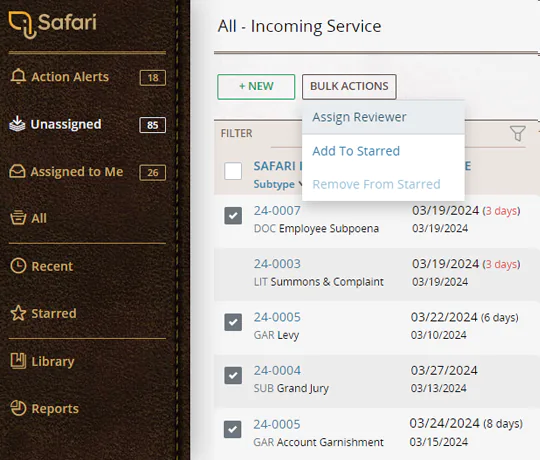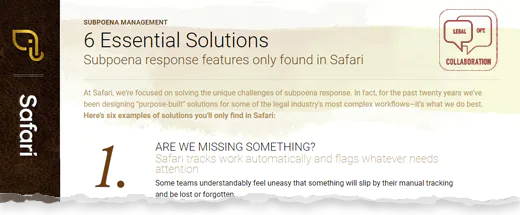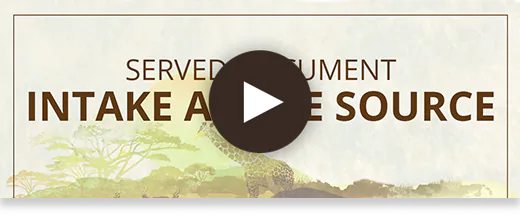SDM streamlines incoming legal document processing
Served Document Management (SDM)refers to the systems and procedures used by companies to efficiently intake, review, and route legal orders to their proper destination. Regardless of the type (e.g. litigation, subpoena, wage garnishment, levy, etc.) each matter will follow a similar path:
SERVED DOCUMENT MANAGEMENT PHASE
Covers intake through routing
- Intake: The process begins as documents are served through a registered agent, paper is delivered to a branch office, or served via email, fax, or paper on your corporate headquarters.
- Review: This usually involves a number of different people and procedures involved in assessing the nature of the served document and what is being requested.
- Routing: Once you determine who should handle the matter, the documents (and any associated metadata) needs to be routed to the appropriate team within your company.
MATTER MANAGEMENT PHASE
Covers processing and response
- Processing: Depending on the nature of the served document, an in-house team will need to take appropriate action to address the legal request.
- Answer / Response: Once the legal request has been processed by an in-house team, the resulting answer or response will need to be delivered to the issuing party.
Why companies are focusing on SDM
In today's environment, having an SDM strategy is essential for:
- Compliance and Legal Obligations: Corporations are subject to various legal obligations and regulatory requirements, including the timely response to legal service of process. Failure to properly manage served documents can result in missed deadlines, fines, or even legal sanctions.
- Risk Management: Without a proper management strategy in place, there is a heightened risk of overlooking important documents or failing to respond promptly, which could expose the corporation to unnecessary legal risks or liabilities.
- Efficiency and Productivity: Manual handling of served documents is time-consuming and prone to errors. A streamlined document management strategy automates routine tasks, such as intake, assignment, and routing, freeing up valuable time and resources.
- Centralized Information and Collaboration: Documents may be served on various sources and without a centralized management strategy, it can be challenging to track and coordinate responses effectively.
 PORTALS SIMPLIFY RESPONSE DELIVERY
PORTALS SIMPLIFY RESPONSE DELIVERYReplace outdated delivery methods like email or sending thumb drives with a secure online portal that's instantly available and completely auditable.
 CENTRALIZED SERVED DOCUMENT REVIEW
CENTRALIZED SERVED DOCUMENT REVIEWImagine how much more efficient your team would be if all legal service was organized into a central queue, with metadata and documents viewable inline, auto-linked to related service, and built-in review tools optimized for quick assessment.
Ask Yourself: How do we currently deal with incoming legal service?
Managing the documents coming into your company from varied sources such as registered agents, paper and email served on your headquarters or branch offices, poses a unique set of challenges. This diversity, while unavoidable, leads to a whole set of challenges including:
- Fragmentation: Legal documents and service of process can arrive through multiple channels, including electronic delivery from registered agents, paper documents via messenger services, or directly to branch offices. This fragmentation makes it difficult to maintain a centralized system for tracking and management.
- Missed Deadlines: Each legal document, whether it's a lawsuit notice, levy, or document request, requires timely action. Mismanagement or delays in processing can lead to missed deadlines, resulting in legal penalties, non-compliance issues, or adverse legal outcomes.
- Inefficiencies: The need to manually sort, catalog, and route documents for review and action can consume significant time and resources. This is further complicated when documents are received in different formats, requiring digitization or manual entry into electronic systems.
- Security Lapses: Handling sensitive legal documents necessitates stringent security measures to protect against unauthorized access and ensure confidentiality. Escalating documents for further legal review also requires clear, enforceable policies for transfer and receipt.
- Tracking Problems: Consolidating data for reporting purposes is more complex when information is scattered across various systems and physical locations. This makes it challenging to create accurate, timely reports on legal service receipts, actions taken, and status updates.
ServePort's SDM completely transforms your intake process
ServePort's intake portals revolutionize how law firms, government agencies, and corporate legal departments receive and handle legal documents. By enabling direct uploads and data entry, our portal ensures that every document arrives organized and precise for:
- Streamlined Document Intake Say goodbye to manual sorting and handling of legal documents. Our portal allows external parties to directly upload documents and input related data, streamlining the intake process and significantly reducing manual effort.
- Enhanced Accuracy and Organization Manual data entry is prone to errors, which can lead to costly mistakes. With our intake portal, the information provided directly by the source ensures higher accuracy. The system automatically organizes documents as they arrive, making it easier to find and manage them.
- Improved Efficiency Automating the intake process not only saves time but also allows your team to focus on more critical tasks. By reducing the time spent on administrative duties, your team can concentrate on analysis, strategy, and client service, leading to better outcomes and increased productivity.
- Secure and Controlled Access Security concerns are paramount when handling sensitive legal documents. Our portal is designed with the highest security standards, including encryption and secure access controls. This ensures that only authorized personnel can access the documents, maintaining confidentiality and compliance.
- Real-time Tracking and Notifications Stay informed with real-time updates. Our portal sends notifications upon the receipt of new documents and allows for tracking the status of each document throughout the processing stages. This transparency ensures that nothing falls through the cracks.
- Easy Integration with Existing Systems Our Legal Service Intake Portal is built to seamlessly integrate with your current legal software systems. This compatibility ensures a smooth transition and allows you to leverage the full potential of your existing technology stack.
NEXT


